
-
Where does electricity come from?
-
How do electric trains move?
-
How do fluorescent lamps glow?
-
Why can we talk through a telephone?
-
How does a microwave heat up food?
-
How do toasters and irons get hot?
-
What makes the crackling sounds when you take off a sweater?
-
What causes lightning?
-
Why don’t birds get shocked when they sit on power lines?
-
Is it true that sunlight can be used to make electricity?
-
Is it true electricity flows in human bodies?
-
How does a TV show images?
-
How come we can talk through a mobile phone?
-
How was the light bulb invented?
-
Electricity flows in some things, but not in others
-
What exactly is electricity?
-
Tell me more about how generators work!
-
Can I generate electricity too?
Where does electricity come from?
Electricity runs the TVs, air-conditioners, and other devices in our homes. Have you ever wondered where electricity comes from? Electricity actually comes from power stations far away from our homes. Electricity travels along very long power lines to reach our homes. There are different kinds of power stations that make electricity. For example, thermal power stations use heat energy to make electricity. Hydroelectric power stations use water power to make electricity.
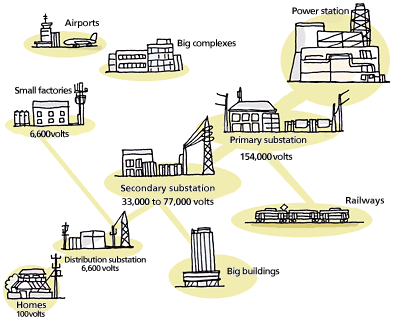
The electricity made at power stations is very powerful. So the electricity’s strength is adjusted at substations before it reaches your home. The strength is lowered to a safe level of between 100 and 240 volts by the time it reaches your home.
How do electric trains move?
Trains are very big and heavy. We know that electric trains move by electricity. But how do they work?
If you look closely, you are sure to see power lines running either above the electric train or alongside the train tracks. Electric trains get their electricity from these power lines. But one power line is not enough for a train to run. Electricity naturally flows from places with a stronger electric force to places with a weaker electric force. This is why two power lines are needed. With an electric train, the train tracks act like the two power lines. In other words, the power lines above the roof have a stronger electric force, and the train tracks have a weaker electric force. So electricity flows from the power lines to the tracks through the wheels and other parts of the train. This electricity runs the train’s motor.
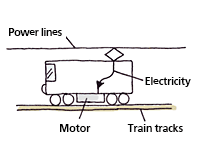
How do fluorescent lamps glow?
Fluorescent lamps light up our homes and classrooms. Fluorescent lamps come in different shapes and sizes. But when you turn on the switch, they all start to glow white after a few seconds. What makes them glow like that?
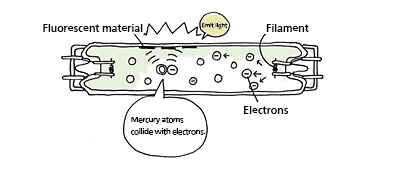
The middle of a fluorescent lamp is like a tube. When you turn on the switch, electricity travels through the space in the tube. The electrons collide with the mercury vapor inside the tube, which creates light. But people can’t see the light made by these collisions. This first light shines against the fluorescent material coated on the inside of the tube. The fluorescent material changes the light into light that we can see. This process is why it takes a few seconds for a fluorescent lamp to start to glow.
Why can we talk through a telephone?
Have you ever played with a string telephone? You can make one by joining two paper cups with a tight string. If you talk into one of the cups, the other person can hear your voice in the other cup. But it’s impossible to talk to people far away with a string telephone. Walls get in the way, and the string can’t be super long.
So why can you talk to people far away with the telephone in your home? The reason is the sound is carried by changing it into electric waves. Why can we talk through a telephone? The paper cup in a string telephone carries the vibrations of your voice along the string. In the same way, the diaphragm in the telephone picks up the vibrations of your voice. The difference is a telephone wire replaces the string. Your voice is changed to electric waves that are carried along the telephone wire. This is how your voice reaches the other person far away almost instantly. The electric waves that reach the other person vibrate the diaphragm in their telephone, so they can hear your voice.
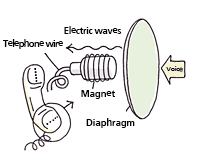
How does a microwave heat up food?
Have you ever wondered how a microwave heats up food? Why does food inside a microwave get hot without using any flames? The answer is a bit hard to understand, so we’ll explain it step by step. First, your food has a lot of water inside it. Water is made up of very tiny particles called water molecules.
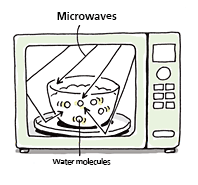
When water is cold, the water molecules move slowly. When water is heated, the water molecules smash into each other. The energy produced by the collisions creates heat. So if you want to heat up food, you need to agitate the water molecules inside the food. This is where the microwave comes in. A microwave oven emits special electric and magnetic waves called microwaves. When these microwaves pass through the food, they cause the water molecules in the food to crash into each other. And that is why the food heats up.
How do toasters and irons get hot?
How do toasters, irons, hair driers, and other appliances that heat up actually produce heat?
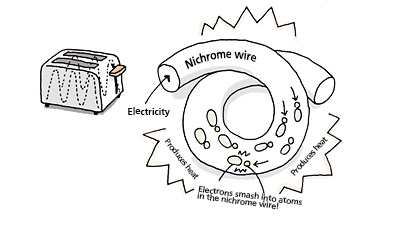
Appliances that produce heat contain special metal wires called nichrome wires. Electricity does not flow easily in nichrome wires. When electricity is forced to flow in nichrome wires, lots of heat is produced. Electricity flows when very tiny electric particles called electrons move among other small particles called atoms and molecules. But when these electrons try to move in a nichrome wire, where electricity does not flow easily, the electrons smash into the atoms and molecules in the nichrome wire. The energy produced when these collisions happen creates heat. So this is how toasters and irons get hot.
What makes the crackling sounds when you take off a sweater?
When you wear a sweater, the sweater rubs against your inner clothing as you move your body. The rubbing causes positive electric charges to gather on one side and negative electric charges on the other. When you take off the sweater, the negative electric charges are drawn toward the positive side and electricity flows. The crackling you hear is the sound of the electricity flowing. And the tingling you might feel comes from touching the electricity. This kind of electricity is called static electricity.
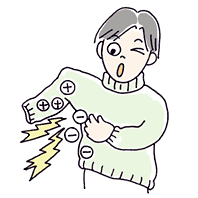
What causes lightning?
Clouds hold fragments of ice, both big and small. Each time the ice fragments crash into each other, some electricity is made. Little by little, this electricity is stored up in the cloud. When the cloud can’t hold all the electricity any more, the electricity suddenly flows in one big jolt toward the ground. This is how lightning works.
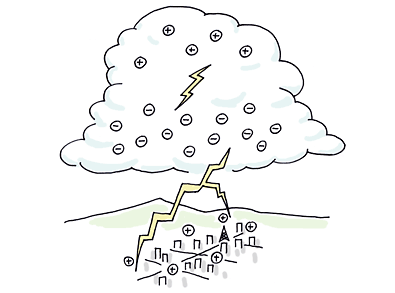
But have you wondered why we see flashes of light and hear loud rumbling sounds? In the instant that the electricity flows toward the ground, it heats up air molecules to very high temperatures over 10,000 degrees Celsius. This makes the air molecules move violently. The movement of air molecules causes the flashes of light and loud thunderclaps. Air normally does not let electricity pass through it. For lightning to happen, an enormous electric force of around 100 million volts builds up in the cloud. With this much force behind it, electricity pushes its way through the air and heads toward the ground. This is why we see lighting follow a zigzag path, rather than moving in a straight line.
Why don’t birds get shocked when they sit on power lines?
Electricity naturally flows from places with a stronger electric force to places with a weaker electric force. But with a single power line, the electric force is nearly the same at all places along the line. This is why electricity doesn’t flow through the birds’ bodies.

Now imagine what would happen if a bird sat across two power lines with different electric forces. The shock from the powerful electricity passing through its body would kill the bird. When electricity passes through a body, we call it an electric shock. In the same way, if you were flying a kite and it hit a power line, electricity would flow from the high-voltage power line to the low-voltage ground and give you a serious electric shock. This is why you should never fly a kite near power lines.
Is it true that sunlight can be used to make electricity?
Most of the electricity you use every day is made from heat energy, wind power, or other sources. But it’d be great if we could make electricity from the light of the sun, which is always peeking its face out from the sky. In fact, there’s a device that can make electricity from sunlight. It’s called a solar cell.
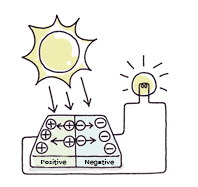
There’s an amazing part inside a solar cell. When sunlight hits this part, it separates the electricity it makes between a part that gathers positive electric charges and a part that gathers negative electric charges. People were able to invent this amazing part, because electricity flows when negative electric charges are drawn toward positive electric charges.
Is it true electricity flows in human bodies?
Yep, it’s true. There’s always a weak amount of electricity flowing in everyone’s body. Imagine you’re playing baseball. When your eyes see a ball rolling toward you, what do you think happens inside your body? Your nerves send a weak electric signal to your brain about what you see or what you want your body to do. For example, the nerves send a signal saying “A ball is coming”. Then your brain sends an electric signal saying “Pick up the ball” to your nerves. Your nerves relay the signal to the muscles in your hands and legs. This is how your body moves to pick up the ball.
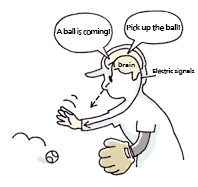
In the similar way, doctors can figure out the condition of your body by the state of the electricity flowing in your body. For example, doctors use machines that measure electric signals in the brain called brain waves or electric signals created by heartbeats. The machines draw the signals as a picture called an electrocardiogram, or ECG. ECGs are useful because doctors can look at them and check for illnesses.
How does a TV show images?
It’s amazing how TVs show our favorite programs on a screen every day. But how do images recorded in another place get to your TV?
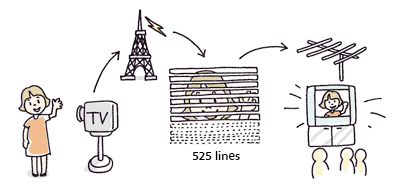
When a TV station sends out images of a person, each picture is first cut into 525 lines. Then each of the lines is turned into the words of electricity, called electric signals. The electric signals are sent through the air from the TV station’s antenna. Your TV receives each of the lines one by one and then puts them in order from top to bottom to piece together the original picture. TV images are sent at a speed of 30 pictures every second. This is why the pictures appear to move on your TV screen.
How come we can talk through a mobile phone?
Mobile phones work by changing your voice into an electric signal and sending that signal to the other person. But the electric signals are not sent directly through the air to the other person from your mobile phone. Electric signals from mobile phones can travel about 2 kilometers at most. So, the electric signals first travel to a base station within range of your mobile phone. Just like with regular telephones, telephone wires connect the base station to a base station near the other person. The base station near the other person sends the electric signals through the air to the other person’s mobile phone.
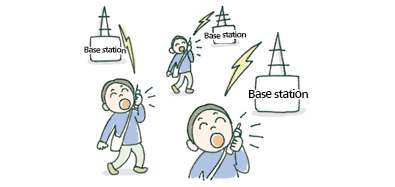
Your voice can be sent through the air either as an analog or digital electric signal. Mobile phones use digital electric signals. With digital electric signals, the vibrations in the air made by your voice are changed into numbers. Because they use numbers, digital electric signals can reach the other person without errors even in bad weather.
How was the light bulb invented?
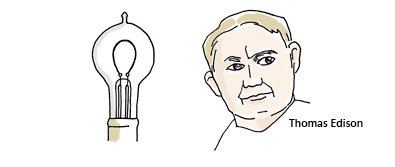
Before electric lights were invented, people used oil-burning lamps, candles, and gas lamps for light at nighttime. But these lights were not very bright. Then came the light bulb, which uses electricity to make bright light. The light bulb was invented by Thomas Edison, the king of American inventors. When electricity is forced to flow through a material that does not let electricity pass easily, that part of the material will emit heat and glow. The light bulb works on this principle. The problem was it was very hard to find a good material that does not let electricity pass easily. Materials that get hot and then burn are no good for a light bulb. Edison tried thousands of experiments trying to invent the light bulb. He found that bamboo grown in Japan was the best material for his light bulb, because it glowed without burning for a long time. In 1879, Edison at long last completed his light bulb! His powerful determination to never give up is what led to his success. An Englishman named Joseph Swan also researched light bulbs. Some say he invented the light bulb before Edison. In any case, Edison and Swan together set up a light bulb company and brought the light bulb to the world.
Electricity flows in some things, but not in others

Electricity passes easily through metals like iron and copper. But electricity does not pass through wood, rubber, glass, and other materials. What is the difference that causes electricity to flow in some things, but not in others? The reason why electricity flows in copper wire and other metals is because metals have electrons that can move around freely inside them. These electrons are called free electrons. Batteries have an electric force inside them. So when a battery is connected to a metal wire, its electric force causes the free electrons inside the metal to move together in one direction. The free electrons move from the negative end of the battery to the positive end. This movement is the flow of electricity. On the other hand, wood, rubber, and other materials do not have a single free electron. That’s why electricity does not flow in these materials.
What exactly is electricity?
Objects are made up of many tiny particles called atoms and molecules. Atoms are connected together by even tinier particles called electrons. As you can see in the picture, several electrons spin in circles around the atom. It’s sort of like how the moon circles the earth. When atoms line up and form a molecule, the electrons start to move like bees flying back and forth between flowers.
Some electrons only spin in circles around the molecule, but other electrons fly around freely. Like in the picture, water is made up of many loose molecules. These molecules do not join together as one object. This is why water changes its shape to match the shape of its container.
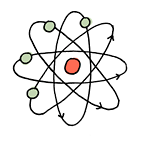
But in metals, all the molecules are strongly connected together. This is why metals are hard. It’s also why electrons can fly around freely inside the metal. These electrons are called free electrons. Free electrons normally move around in all different directions. But when they move and flow in a certain direction, that movement becomes electricity. So if someone asks you “What is electricity?”, you can answer: “Electricity is the flow of tiny particles called electrons that move around inside a metal wire”. Such flows of electrons can happen naturally. For example, have you ever been surprised by a sparking sound when you try to open a door? That is a kind of electricity called static electricity. But static electricity happens only with a small part of an object and only lasts a very short time. So static electricity can’t be used to light a light bulb, for example. The electricity we use every day is dynamic electricity, not static electricity. In other words, we can’t use electricity that doesn’t continually flow in a fixed direction with a nearly constant force. Generators are what produce the electricity we need.
Tell me more about how generators work!
Have you read the What exactly is electricity? page? On this page, we’ll look at how electricity is generated. We will look at how to generate electricity that always flows in a fixed direction with a constant force. As we saw on the previous page, this type of electricity is useful for us. In 1831, an English scientist named Michael Faraday discovered the principle that makes electricity.
The picture shows a metal wire wound around and around to form a coil. Faraday discovered that when he inserted a magnet inside the coil, the free electrons inside the metal wire would start to flow in a fixed direction. This was caused by the magnetic force of the magnet. The faster the magnet moves through the coil, the stronger the flow of free electrons and the stronger the electricity. The problem was it was very hard to move the magnet through the coil again and again at a high speed. So what do you think the solution was?
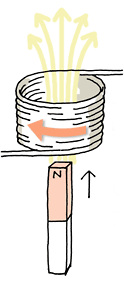
What about turning the coil rather than moving the magnet? When Faraday tried this, he found electricity was generated just like before. Turning the coil is much easier! But is there an even better way to make electricity? People around the world are always trying to answer this question by running many experiments. Because of these experiments, people have created many useful devices. Today, most large power generators produce electricity by spinning a coil inside a magnet. For example, think about a hydroelectric power station at a dam that you might see in the mountains. The dam partially blocks a river to raise the water level. When the water falls from the top of the dam, its force turns a special water wheel called a turbine. The turbine then spins the coil. That is how a hydroelectric power station works. At a thermal power station, coal or other fuels are burned to boil water. The force of the steam rising up from the boiling water turns a turbine. These days, you can often see wind turbines on cliffs and mountains. When their big blades turn, they also turn coils to generate electricity. In short, as long as you have a force to turn a coil, then you can generate electricity by nearly any means.
Can I generate electricity too?
Of course you can. As you saw on the page about how to generate electricity, electricity is made when you turn a magnet near a coil of metal wire.
The idea is shown in the picture. Just place a magnet over a coil and spin the magnet around the coil. If you spin the magnet by hand, electricity will be generated. The faster you spin, the stronger the electricity. But it’s hard to keep the magnet spinning all the time. Is there anything you know that spins around and around every day? How about bicycle wheels? When you ride a bicycle at night, the spinning of the wheel is used to power the bicycle’s light. That is, in fact, a generator that makes electricity.
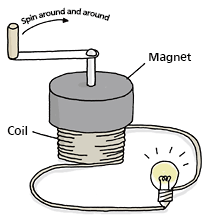
When you press the generator’s roller against the wheel, the spinning wheel turns the roller, which turns the coil inside the generator. The bicycle’s light glows because of the electricity made by the generator. When the roller presses against the wheel, you can feel it’s a little harder to pedal than normal. The harder you pedal, the stronger the electricity and the brighter the light. It’s simple, right! A small device that generates electricity in this way is called a dynamo. Another familiar example of a generator that uses a dynamo is a hand-crank flashlight. By turning the crank around and around many times, the spinning generates electricity that powers the light. A hand-crank flashlight is very useful when the power goes out due to a storm or emergency, although your hands will get tired keeping the light on for a long time. Wind turbines for homes are also sold. You will likely see more and more of them in the future. There are also portable generators that look like car engines that turn coils to generate electricity for outdoor food stalls. Look for them the next time you are at an outdoor festival or fair.



